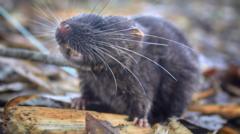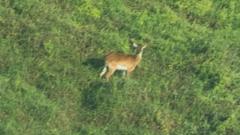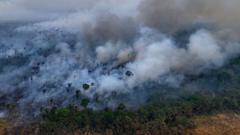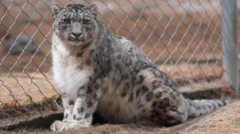An expedition led by Conservation International and local indigenous groups in Peru’s Alto Mayo has resulted in the discovery of 27 new species, including an amphibious mouse and various other vertebrates, underscoring the region's rich biodiversity despite environmental challenges.
Peru's Rich Biodiversity Revealed as 27 New Species Discovered

Peru's Rich Biodiversity Revealed as 27 New Species Discovered
From webbed-footed mice to unique fish, scientists unveil incredible findings in Peru’s Alto Mayo region.
The recent exploration in Peru’s Alto Mayo region has led to astounding discoveries, including 27 new species that range from an amphibious mouse equipped with webbed feet to a uniquely shaped "blob-headed" fish. This undertaking was carried out by scientists from Conservation International alongside local indigenous groups, notably the Awajún people, who have extensively engaged in preserving their natural and cultural heritage. The expedition not only highlights the vibrant biodiversity of the Amazon rainforest but also raises awareness of the potential existence of up to 48 additional species that require further investigation.
According to Trond Larsen, senior director at Conservation International, “Finding this many new species of mammals and vertebrates is remarkable, particularly in a landscape predominantly shaped by human activity.” The Alto Mayo area, recognized for its diverse ecosystems and rich Indigenous territories, faces significant environmental stress due to deforestation and agricultural development, making these discoveries even more critical.
Among the remarkable findings was a new dwarf squirrel species, measuring only 14 cm—half the size of the typical grey squirrel. Its charming chestnut-brown hue and nimble movements captivated researchers. Furthermore, the newly identified spiny mouse flaunts distinctive stiff guard hairs reminiscent of hedgehog spines.
Scientists were particularly astonished by the blob-headed fish, a notable addition to their research; however, the Awajún people were already familiar with this unique aquatic species prior to the expedition. This convergence of traditional knowledge and scientific discovery reminds us of the invaluable insights indigenous communities bring to biodiversity conservation.
As stated by Yulisa Tuwi, an Awajún contributor to the research, this report enables the Awajún to “protect our culture, natural resources and our territory,” revealing the crucial role of community involvement in ecological studies. The exploration further included eight new fish varieties, three amphibian types, and ten butterfly species, reinforcing the need for ongoing ecological research in the region affected by human encroachment.
The findings of this expedition serve as both an enlightening chapter in the understanding of Peru's ecology and as a clarion call for conservation efforts, stressing the need to protect these delicate ecosystems amid growing environmental pressures.
According to Trond Larsen, senior director at Conservation International, “Finding this many new species of mammals and vertebrates is remarkable, particularly in a landscape predominantly shaped by human activity.” The Alto Mayo area, recognized for its diverse ecosystems and rich Indigenous territories, faces significant environmental stress due to deforestation and agricultural development, making these discoveries even more critical.
Among the remarkable findings was a new dwarf squirrel species, measuring only 14 cm—half the size of the typical grey squirrel. Its charming chestnut-brown hue and nimble movements captivated researchers. Furthermore, the newly identified spiny mouse flaunts distinctive stiff guard hairs reminiscent of hedgehog spines.
Scientists were particularly astonished by the blob-headed fish, a notable addition to their research; however, the Awajún people were already familiar with this unique aquatic species prior to the expedition. This convergence of traditional knowledge and scientific discovery reminds us of the invaluable insights indigenous communities bring to biodiversity conservation.
As stated by Yulisa Tuwi, an Awajún contributor to the research, this report enables the Awajún to “protect our culture, natural resources and our territory,” revealing the crucial role of community involvement in ecological studies. The exploration further included eight new fish varieties, three amphibian types, and ten butterfly species, reinforcing the need for ongoing ecological research in the region affected by human encroachment.
The findings of this expedition serve as both an enlightening chapter in the understanding of Peru's ecology and as a clarion call for conservation efforts, stressing the need to protect these delicate ecosystems amid growing environmental pressures.



















